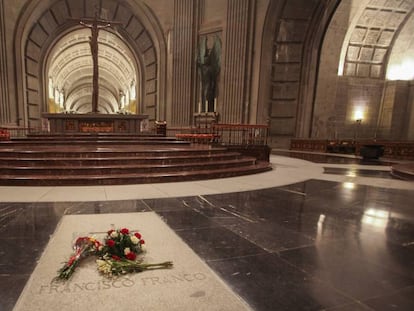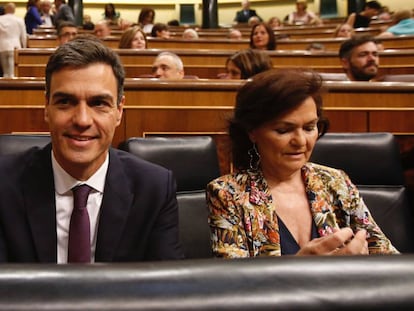Spanish Cabinet approves decree to exhume Franco’s remains
A modification of the Historical Memory Law will legally safeguard the exhumation of the former dictator, before the initiative is put to a historic vote in Congress

Forty-three years after the death of Spanish dictator Francisco Franco, the Socialist Party (PSOE) government of Prime Minister Pedro Sánchez has begun the complex process of exhuming his remains from the Valley of the Fallen memorial site.
Today, the Cabinet approved a legislative decree that will add a pair of articles to the Historical Memory Law to legally safeguard the exhumation. Once approved, the decree will be put to a historic vote in Congress.
Democracy is not compatible with a tomb that honors the memory of Franco
Deputy Prime Minister Carmen Calvo
“The government has approved a decree that modifies two aspects of the 2007 [Historical Memory] law,” announced Deputy Prime Minister Carmen Calvo at a press conference on Friday after the Cabinet meeting. “The decree will permit the exhumation of the remains of the dictator Francisco Franco from the place where the victims of the conflict lie,” she said, in reference to the Valley of the Fallen monument.
“Having the tomb of Franco there means a lack of respect and peace for the victims who are buried within,” Calvo continued. “We want to do this because we think that there is a lot left to do in terms of historical memory in our country. There is not a single democracy on the international stage with which we would like to compare ourselves that has maintained a situation like the one that we have maintained for 40 years. Democracy is not compatible with a tomb that honors the memory of Franco.”
The deputy prime minister went on to explain that the Franco family will have two weeks to take charge of the remains of the former dictator, and should they fail to do so, the Spanish government will choose a “dignified and respectful” place for him to be reinterred.
Asked why the government has chosen to do this now, Calvo responded saying: “We are late with this, we are all late with this, us too, but this government headed by Pedro Sánchez will not be late. Bear in mind that the Historical Memory Law dates from 2007.”

Dozens of people staged a protest at the Valley of the Fallen on Friday to protest against the government’s decision.
The conservative Popular Party (PP) and the center-right party Ciudadanos have already announced they will not support the decree. But the Spanish government is confident the measure will pass, given that it only needs a simple majority (more votes in favor than against) in Congress, and, in principal, has the backing of anti-austerity party Podemos, the Catalan Republican Left (ERC), the Democratic Party of Catalonia (PDeCAT) and the Basque Nationalist Party (PNV). Together, this gives the government 177 votes in favor – one more than an absolute majority.
The decree has been designed to give the exhumation the greatest legal coverage possible
The government has also overcome the potential obstacle presented by the Catholic Church. The body of the dictator is buried in a basilica, a holy site theoretically protected by an international agreement. But from the outset the Church has been receptive to the government’s plans to remove the remains of the dictator. Sánchez has spoken with the archbishop of Madrid, Carlos Osoro, who assured there would be no opposition on their part.
The legislative decree has been designed to give the exhumation the greatest legal coverage possible and prevent possible legal disputes with the surviving members of the Franco family, who oppose the move. Only Congressional groups can bring a complaint against a law, meaning the family will be unable to file a lawsuit against the government.
The PP, however, has said it will appeal the measure with the Constitutional Court, arguing that using a decree to change the legislation is not valid because it does not respond to a situation of urgent need.
The exact date for the exhumation, which will require the removal of a tombstone weighing 1,500 kilograms, is not yet known. PSOE parliamentary spokesperson Adriana Lastra says the government will not announce a date until the last minute in order to avoid protests and other disputes. Lastra has suggested the remains could be removed in September. Sánchez had previously promised to exhume the dictator in July but complications delayed the operation. Now, after 43 years, the process is about to go into motion, with the decree allowing for a 12-month time period after it is passed for the exhumation to take place.
The decree is expected to have 177 votes in favor – one more than an absolute majority
The 13.6-square kilometer Valley of the Fallen site, north of Madrid, remains hotly contested in a country still struggling to come to terms with the legacy of the fascist dictatorship of Franco, who was the Spanish head of state from the end of the Civil War in 1939 to his death in 1975.
The site was ostensibly built to commemorate all of the victims on both sides of Spain’s bitter and bloody Civil War, and the remains of more than 33,000 victims of the conflict lie there. But critics point out that the Valley of the Fallen, which features a basilica and a 150-meter-high cross that dominates the surrounding countryside, contains just two marked graves: those of Franco himself and José Antonio Primo de Rivera, the founder of the Falange, Spain’s fascist-inspired political party. At the same time, thousands of prisoners of war who fought against Franco in the civil conflict were among the workforce used in its construction.
English version by Melissa Kitson.
Tu suscripción se está usando en otro dispositivo
¿Quieres añadir otro usuario a tu suscripción?
Si continúas leyendo en este dispositivo, no se podrá leer en el otro.
FlechaTu suscripción se está usando en otro dispositivo y solo puedes acceder a EL PAÍS desde un dispositivo a la vez.
Si quieres compartir tu cuenta, cambia tu suscripción a la modalidad Premium, así podrás añadir otro usuario. Cada uno accederá con su propia cuenta de email, lo que os permitirá personalizar vuestra experiencia en EL PAÍS.
¿Tienes una suscripción de empresa? Accede aquí para contratar más cuentas.
En el caso de no saber quién está usando tu cuenta, te recomendamos cambiar tu contraseña aquí.
Si decides continuar compartiendo tu cuenta, este mensaje se mostrará en tu dispositivo y en el de la otra persona que está usando tu cuenta de forma indefinida, afectando a tu experiencia de lectura. Puedes consultar aquí los términos y condiciones de la suscripción digital.
More information
Archived In
Últimas noticias
Most viewed
- Alain Aspect, Nobel laureate in physics: ‘Einstein was so smart that he would have had to recognize quantum entanglement’
- Mexico’s missing people crisis casts a shadow over World Cup venue
- Why oil has been at the center of Venezuela-US conflicts for decades
- Trump clarifies who is ultimately in charge in Venezuela: ‘Me’
- Mexico seeks to shore up its defenses following US incursion in Venezuela










































